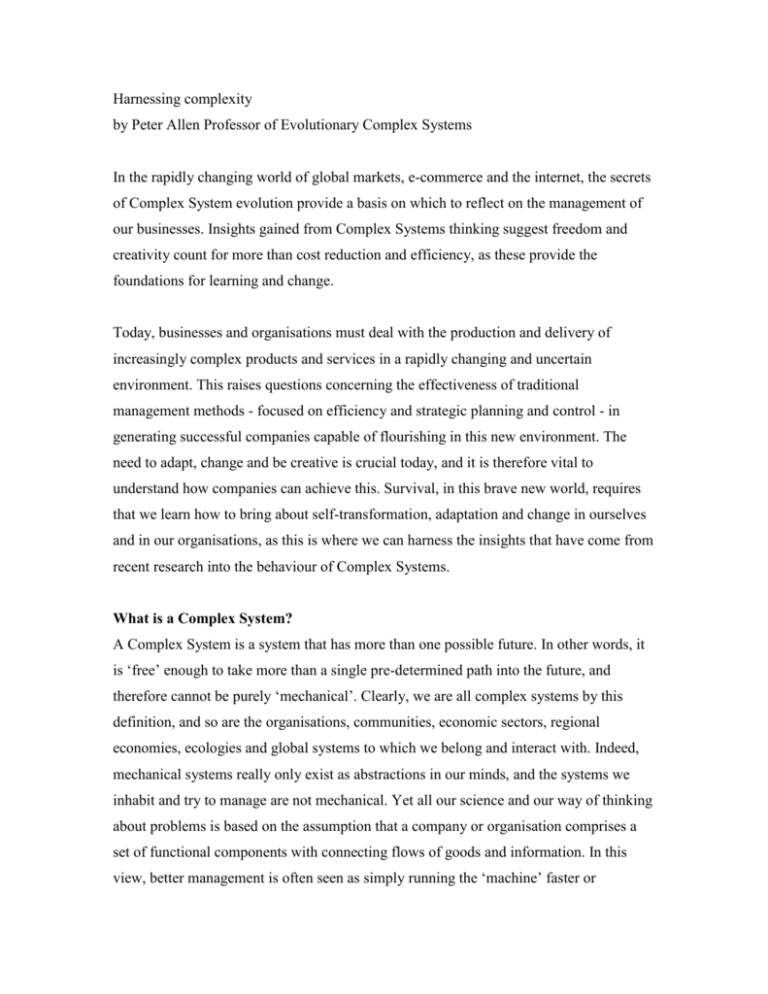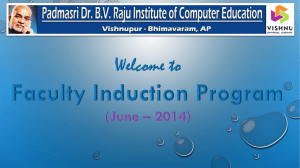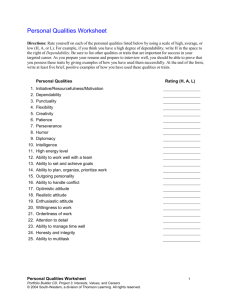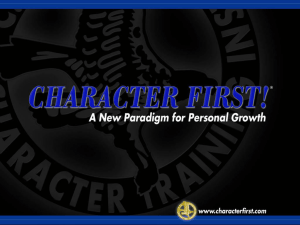Harnessing complexity - Cranfield School of Management
advertisement

Harnessing complexity by Peter Allen Professor of Evolutionary Complex Systems In the rapidly changing world of global markets, e-commerce and the internet, the secrets of Complex System evolution provide a basis on which to reflect on the management of our businesses. Insights gained from Complex Systems thinking suggest freedom and creativity count for more than cost reduction and efficiency, as these provide the foundations for learning and change. Today, businesses and organisations must deal with the production and delivery of increasingly complex products and services in a rapidly changing and uncertain environment. This raises questions concerning the effectiveness of traditional management methods - focused on efficiency and strategic planning and control - in generating successful companies capable of flourishing in this new environment. The need to adapt, change and be creative is crucial today, and it is therefore vital to understand how companies can achieve this. Survival, in this brave new world, requires that we learn how to bring about self-transformation, adaptation and change in ourselves and in our organisations, as this is where we can harness the insights that have come from recent research into the behaviour of Complex Systems. What is a Complex System? A Complex System is a system that has more than one possible future. In other words, it is ‘free’ enough to take more than a single pre-determined path into the future, and therefore cannot be purely ‘mechanical’. Clearly, we are all complex systems by this definition, and so are the organisations, communities, economic sectors, regional economies, ecologies and global systems to which we belong and interact with. Indeed, mechanical systems really only exist as abstractions in our minds, and the systems we inhabit and try to manage are not mechanical. Yet all our science and our way of thinking about problems is based on the assumption that a company or organisation comprises a set of functional components with connecting flows of goods and information. In this view, better management is often seen as simply running the ‘machine’ faster or more efficiently. But that was when life was simple and the ‘product’ or ‘service’ to be produced and delivered only needed to be made at a competitive cost with adequate quality. Today, we must constantly create new products and services, with additional and novel attributes, and this creative, adaptive capacity will be more important to our survival than our level of efficiency, particularly if, as Complex Systems thinking suggests, efficiency reduces creativity. Traditionally, decision making and strategy have been based on a rational set of assumptions such as: we know our options we know and can evaluate the (single) outcome of implementing each of them we can ignore effects that we do not know the environment in the future ‘after’ the decision is known there was a situation ‘before’ our decision, and that there will be a situation ‘after’ our decision, and that we can therefore examine the differences between them. Such reflections are typical of a cost/benefit analysis, for example, by which the outcomes of different possible decisions are compared. Yet, in a world of rapid change and uncertainty, the assumptions relied upon by this kind of ‘reasonable’ behaviour are simply not true. In reality we do not necessarily know all our options, the path the system may take, the possible dimensions that might be affected by resulting changes, or how circumstances may have changed in the mean time. In short, our view of our organisation as a machine, sitting in a fixed or at any rate predictable environment, is totally inadequate. We must instead turn to new ideas - we must harness the ideas arising from Complex Systems. Complex Systems behaviour In studying Complex Systems, initially in physics and chemistry, it became clear that the key properties of ‘open’ systems, where flows of matter, energy and information can occur across their boundaries, were that they could undergo spontaneous transformations of structure and functionality (See Box 1). Instead of a ‘fixed’ mechanical system, this showed how systems came into being, and evolved over time, changing structurally, gaining, and sometimes shedding, complexity and qualities. The study of Complex Systems therefore revealed a co-evolutionary process of a system and its environment in which successive change and adaptation each involved two separate steps: discovering what to do (exploration and evaluation) doing what has been decided (implementation). And these two steps are radically different in nature. In Complex Systems, the first step is ‘taken’ by the ‘non-average’ underlying elements within the system, while the second – the emergence of a transformed, functioning system - concerns new, effective ‘average’ behaviour of the elements. The successful coevolution of a system with its environment therefore occurs through the dynamic interplay of the average and non-average behaviours within it. Successive instabilities occur each time that existing structure and organisation fail to withstand the impact of some new circumstance or behaviour. When this occurs, the system re-structures and becomes a different system, subjected in its turn to the disturbances from its own nonaverage individuals and situations. It is this dialogue between successive ‘systems’ and their own inner ‘richness’ that provides the capacity for continuous adaptation and change. Lessons for business Clearly, these two steps will seem obvious to anyone running a business - firstly, we work out what product or service we think will succeed, and then organise a system to produce and deliver it as efficiently as possible. In a world of slowly changing markets and fixed technologies, this could be undertaken once, or very infrequently, and the system optimised. However, in our world of fast-changing markets, competitors and technologies, there is a constant need to keep revising and up-dating knowledge and information about possible markets, customer needs and technical possibilities. Step 1 requires that we explore the possibilities in order to discover possible options and decide from them what to do. We need to be good at ‘going beyond’ present knowledge and wandering into undiscovered territory. But, in order to perform step 2 successfully, we need to execute what has been decided as efficiently and fast as possible, avoiding any unnecessary waste. This requires rational analysis to obtain mechanical and economic optimisation. The qualities required for Step 1 are the freedom and ability to move into uncharted territory and have new thoughts, while those required for Step 2 are the ability to make and act upon rational analyses of the processes and costs of the system Ð but these are opposite qualities. And, not only that, pressure for greater measurable accountability, short term share-holder value and the increasing use of IT makes it increasingly more difficult to protect the presence of the qualities required for Step 1 against the simpler, more easily measured qualities for Step 2. Yet without Step 1 there can be no Step 2! Imagination and creativity must precede efficiency of execution. Complex Systems models and simulations demonstrate the truth of this statement, showing the role of individual diversity in Step 1 creativity and exploring the circumstances which may require more or less focus on Step 1 or Step 2 qualities. Aerospace Design Process A current piece of research concerns the way in which new knowledge and technology is explored in creating a very complex product such as a new aeroplane. Part of the technology budget is specifically allocated to a free exploration of ideas by young technologists in the group. There are prizes for success and bidding rounds for further support. They are allowed to talk freely to suppliers if this is important. Precise, detailed accountability is not applied to this exercise, but instead the judgement of the Head of Technology is confirmed through the overall long-term capacity of the section to deliver new technology when required. This company has a long and successful history in this highly competitive and innovative sector. The Prato District Network in Italy Just 15 km from Florence, the small Prato District encompasses one of the largest concentrations of textile manufacturing in Europe. There are over 8,000 companies, employing 44,000 people, with production of $4.5 billion. Activity here dates back 1,000 years and this long evolution has led to this adaptable social network, founded on longterm social relationships, that allows them to respond more rapidly than competitors to the uncertain and changing fashion market. (Current PhD Thesis by Jane Gillies) Complex Systems thinking provides a framework that can inform every aspect of business management, linking research, development, concept and design with imaginative market exploration, human resources management, and overall business strategy and identity. It concerns the complete ‘knowledge dynamics’ that drives the company - right through the creation, evaluation, selection, implementation and discarding of knowledge. It demonstrates that this is the power behind the competitiveness of new growth companies and indicates how it can be adopted by businesses and by whole business networks. Ultimately, the creativity and imagination of a business will come from the dynamic interaction of diverse individuals. These individuals that create new ideas and value may be within one company, but often will span several within the network, giving rise to winning clusters of activity, capable of evolving faster than their rivals. Complex Systems thinking also informs us how to achieve a high rate of delivery of new products and services and rapid adaptation to changing conditions. Instead of designing and planning products and services as a ‘top-down’ exercise through a captive ‘supply chain’, the models of self-organising networks provide an alternative view. Here, products emerge as the result of a changing pattern of collaboration of a network of suppliers, both competing and co-operating, each expert in its own domain. The network is characterised by long-term relationships between nodes, but does not always require the same partners to be involved all the time. Different nodes can rapidly come together or separate for the production and delivery of different things. In the rapidly changing world of global markets, e-commerce, evolving telecommunications and internet, the secrets of Complex System evolution offer us a basis on which to reflect on the management of our businesses. They tell us not to allow optimisation on any single criteria (eg. cost minimisation) and to provide freedom and resources to those parts of the business that must be creative, while regulating closely those parts that are purely bureaucratic. Making sure that designs and decisions are always debated among a diverse group of individuals, and that different perspectives are discussed and examined, we need to encourage people to express their individual views and differences and to have enough self-confidence to question their present activity and knowledge. Allowing exploration and experiment means tolerating ‘failure’ and being open to new ideas requires an atmosphere of confidence and trust, which in turn requires a long-term social relationship. The insights coming from Complex Systems thinking tell us that such things matter more than cost reduction and efficiency, as they provide the basis for a sustainable adaptive capacity for learning and change.









